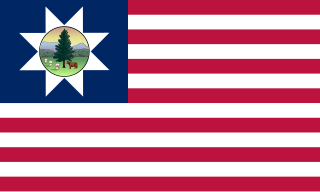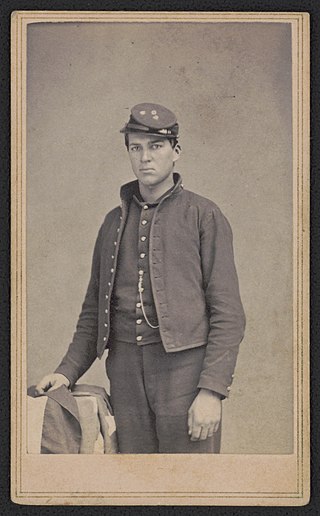
John Irvin Gregg was a career U.S. Army officer. He fought in the Mexican–American War and during the American Civil War as a colonel and near the end of the war as a brevet general in the Union army. In 1866, he was nominated and confirmed as a brevet major general of volunteers and a brevet brigadier general in the Regular Army, both to rank from March 13, 1865.

The 1st Vermont Cavalry Regiment was a three years' cavalry regiment in the Union Army during the American Civil War. It served in the Eastern Theater from November 1861 to August 1865, in the Cavalry Corps, Army of the Potomac.
The 7th Kentucky Infantry Regiment was an infantry regiment that served in the Union Army during the American Civil War.
The 6th Pennsylvania Cavalry was a Union Army cavalry regiment that served in the Army of the Potomac and the Army of the Shenandoah during the American Civil War. It was formed in 1861 as the Philadelphia Light Cavalry and the 70th Regiment of the Pennsylvania Volunteers by Richard H. Rush who also served as colonel from 1861 to 1862. At the request of Major General George B. McClellan, the regiment was equipped with lances which prompted the unit to be known as "Rush's Lancers." The lances proved ineffective in battle and the regiment was issued carbine rifles in 1863. The regiment served in many of the key battles in the Eastern theater of the American Civil War and were mustered out in August 1865.
Anderson Troop was an independent cavalry company that served in the Union Army during the American Civil War. It had an authorized strength of 110 officers and men, and served for 18 months at the headquarters of Generals Don Carlos Buell and William S. Rosecrans, commanders of the Department and Army of the Ohio and Cumberland. The unit was frequently referred to as "Anderson Troop, Pennsylvania Cavalry", and while occasionally identified as the 15th Pennsylvania Cavalry because its officers raised and organized that regiment, it was never a part.

The 82nd Ohio Infantry Regiment, sometimes 82nd Ohio Volunteer Infantry was an infantry regiment in the Union Army during the American Civil War.
The 2nd Ohio Cavalry Regiment was a cavalry regiment that served in the Union Army during the American Civil War.
The following list is a Bibliography of American Civil War Union military unit histories. More details on each book are available at WorldCat.
The 75th Regiment Pennsylvania Volunteer Infantry was a unit of the Union Army during the American Civil War. It was composed almost entirely of German-speaking residents of Philadelphia and newly arrived German immigrants. Total enrollment, over the course of the war, was 1,293 officers and men. The 75th Pennsylvania participated in several major battles including Second Bull Run, Chancellorsville, and Gettysburg. The regiment was transferred to the Western Theater in September, 1863. There, it participated in operations in Tennessee, before it was mustered out of service on September 1, 1865, following the close of the war.
The 99th Regiment Pennsylvania Volunteer Infantry was an infantry regiment that served in the Union Army during the American Civil War.

The 110th Pennsylvania Volunteer Infantry was an infantry regiment that served in the Union Army during the American Civil War.
The 84th Pennsylvania Volunteer Infantry was an infantry regiment that served in the Union Army during the American Civil War.
The 1st Pennsylvania Cavalry was a cavalry regiment that served in the Union Army as part of the Pennsylvania Reserves infantry division during the American Civil War.
The 88th Regiment, Pennsylvania Volunteer Infantry was an infantry regiment that served in the Union Army during the American Civil War.

The 56th Pennsylvania Volunteer Infantry was an infantry regiment that served in the Union Army during the American Civil War. The unit has the distinction of being the first Union Army infantry regiment to open fire at the Battle of Gettysburg.

The 2nd Pennsylvania Reserve Regiment also known as the 31st Pennsylvania Volunteer Infantry was an infantry regiment that served in the Union Army as part of the Pennsylvania Reserves infantry division during the American Civil War.
The 6th Pennsylvania Reserve Regiment also known as the 35th Pennsylvania Volunteer Infantry was an infantry regiment that served in the Union Army as part of the Pennsylvania Reserves Infantry Division during the American Civil War.
The 51st Pennsylvania Volunteer Infantry was an infantry regiment that served in the Union Army during the American Civil War.
The 82nd Pennsylvania Volunteer Infantry was an infantry regiment that served in the Union Army during the American Civil War. It was designated the 31st Pennsylvania Volunteer Infantry until after the Battle of Seven Pines but changed to avoid confusion with the 2nd Pennsylvania Reserve Regiment, which was renumbered.

The 2nd New York Cavalry Regiment, officially known as the 2nd Regiment, New York Volunteer Cavalry, was a unit of the Union Army during the American Civil War. It served with the Army of the Potomac and fought in Stoneman's 1863 raid, the Wilson–Kautz Raid, and the Battle of Appomattox Station.









